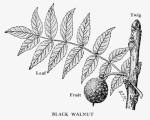Bark - thick, dark, deeply furrowed with rounded ridges between; grayish
brown in color; inner bark dark chocolate brown in color.Twigs - at first hairy, later smooth, stout,
brittle, orange brown in color, cream-colored chambered pith.
Winter buds -
terminal bud pale, downy, scarcely longer than broad, blunt-pointed, less than 1/3 inch
long; lateral buds less than 1/6 inch long.
Leaves - alternate,
compound, with 13 to 23 leaflets; leaflets 3 to 4 inches long, sharp-pointed, serrate
along margin, usually stalkless; leaves up to 2 feet in length.
Fruit - a round nut,
1 1/2 inches in diameter, black, the surface roughened by rather coarse ridges, enclosed
in a yellowish green, fleshy husk, usually solitary or in clusters of 2, ripening in
October. Kernel - sweet, edible, and when properly cured somewhat easier to extract than
the butternut. It is necessary to remove the outer husk if nuts are to be stored.
Distinguishing features
- large round nut; cream-colored, chambered pith.
[introduction] [the keys] [list of 50 trees] [making a tree collection]
[back to the homepage]
|
